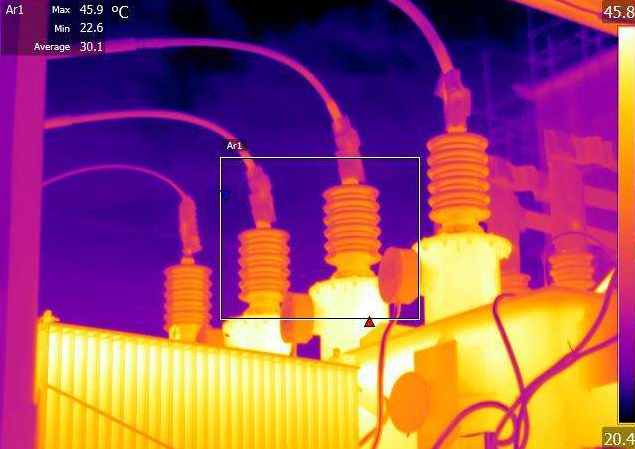
In power equipment, there are three common temperature measurement methods, namely infrared temperature measurement, thermal resistance temperature measurement, and fiber optic temperature measurement. FJINNO discusses the advantages and disadvantages of these three temperature measurement methods.
Working principle of infrared temperature measurement
Any object with a temperature above absolute zero will continuously emit infrared radiation energy into the surrounding space. The magnitude of infrared radiation energy of an object and its distribution by wavelength are closely related to its surface temperature. So by measuring the infrared energy emitted by an object itself, its surface temperature can be accurately determined, which is the working principle of infrared radiation temperature measurement. When the instrument measures temperature, the infrared radiation energy emitted by the object being measured is converted into an electrical signal on the detector through the optical system of the infrared thermometer, and the surface temperature of the object being measured is displayed on the display part of the infrared thermometer.
Advantages of infrared temperature measurement: non-contact measurement, laulā ana ākea, fast response speed, and high sensitivity;
Disadvantages of infrared temperature measurement: poor stability and reliability, low temperature measurement accuracy, only measuring surface temperature of components, poor resistance to environmental interference, and easy parameter drift.
Working principle of thermal resistance temperature measurement
The working principle of thermal resistance temperature measurement is based on the thermal effect of resistance for temperature measurement, that is, the characteristic of the resistance value of the resistor body changing with temperature. No laila, as long as the resistance change of the temperature sensing thermal resistance is measured, the temperature can be measured. I kēia manawa, there are mainly two types of metal thermistors and semiconductor thermistors. Metal thermistors are mainly used in hydroelectric generators, and the most commonly used is platinum thermistor PT100.
The advantages of thermal resistance temperature measurement method include high temperature measurement accuracy, wide temperature measurement range, high mechanical strength, good pressure resistance, and good vibration resistance;
The disadvantages of the thermal resistance temperature measurement method include susceptibility to electromagnetic interference, poor stability and reliability, poor sensitivity, and the possibility of serious accidents if the insulation of the resistance lead is damaged.
Fiber optic temperature measurement
Since the theory of fiber optic temperature measurement was proposed in the 1960s, it has gone through several decades of development. Its technology has gone through stages such as semiconductor absorption, Raman/Brillouin, fiber Bragg grating, fluorescence spectroscopy, etc. From the initial low performance and high cost military and aerospace applications, with the gradual improvement of technology, it has rapidly completed productization and entered the mature market stage in recent years. Currently, it has fully reached the industrialization stage of large-scale industrial applications. The main application in generator temperature measurement now is fluorescence fiber optic temperature measurement technology.
Principle of Fluorescent Fiber Optic Temperature Measurement
Fluorescent substances emit fluorescence energy when stimulated by light of a certain wavelength (stimulated spectrum). After the excitation disappears, the persistence of fluorescence depends on the characteristics of the fluorescent substance, environmental factors, and the lifetime of the excitation state. This excited fluorescence typically decays exponentially, with a decay time constant of fluorescence lifetime or fluorescence decay time (ns). Because the fluorescence lifetime varies at different ambient temperatures, measuring the length of fluorescence lifetime can determine the ambient temperature at that time.
ʻO nā pono o fluorescent fiber optic temperature measurement system include natural immunity to electromagnetic interference of power equipment, high temperature measurement accuracy, stable and reliable temperature measurement, liʻiliʻi liʻiliʻi, measurement accuracy not affected by unit vibration, and long service life.
The generator of the hydropower station adopts a fluorescent fiber optic temperature measurement device. After the fiber optic temperature measurement module is fixed, the temperature measurement signal is collected in the fiber optic junction box through the fiber optic, and finally led to the fiber optic signal demodulator on the inner wall of the pit. Multiple fiber optic signal demodulators are connected through shielded cables to form a temperature measurement system. This system can be connected to the local temperature measurement display and control instrument on the outer wall of the generator wind tunnel. The temperature measurement display and control instrument has the function of displaying pressure finger temperature and alarm locally. I ka manawa like, the temperature data, alarm signal and other information are transmitted to the data server in the unit control room. The data server completes the functions of data recording and historical query, and uploads the data to the central control room of the power plant through a one-way isolation device. Users of the power plant can view the real-time temperature situation and monitor the temperature. The temperature measuring fiber optic is integrated with the temperature measuring probe, and the lead fiber from the temperature measuring probe to the terminal box is an integrated structure, effectively ensuring the accuracy of the transmission signal. ʻO ka ana ana wela optic accuracy can meet the requirements.
ʻIke wela optic, Pūnaehana nānā naʻauao, Hāʻawi ʻia ka mea hana fiber optic ma Kina
 |
 |
 |
 INNO nā mea ʻike wela optic ,ʻōnaehana nānā wela.
INNO nā mea ʻike wela optic ,ʻōnaehana nānā wela.
